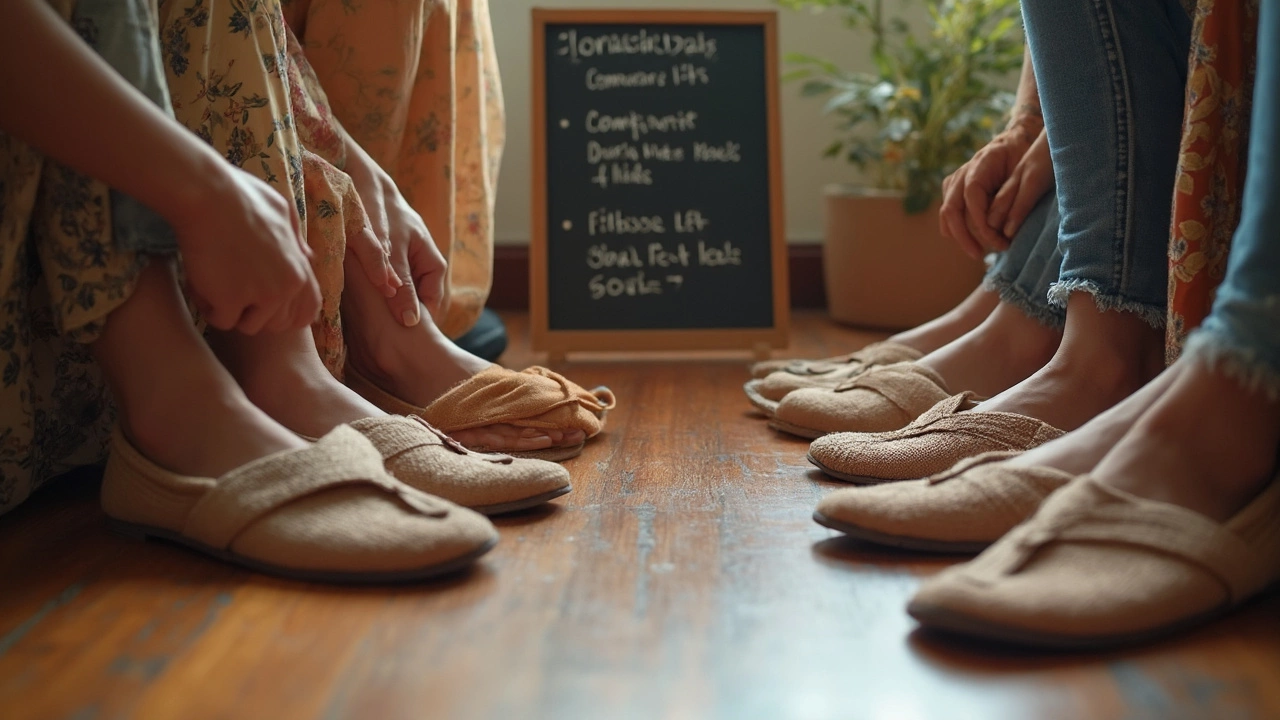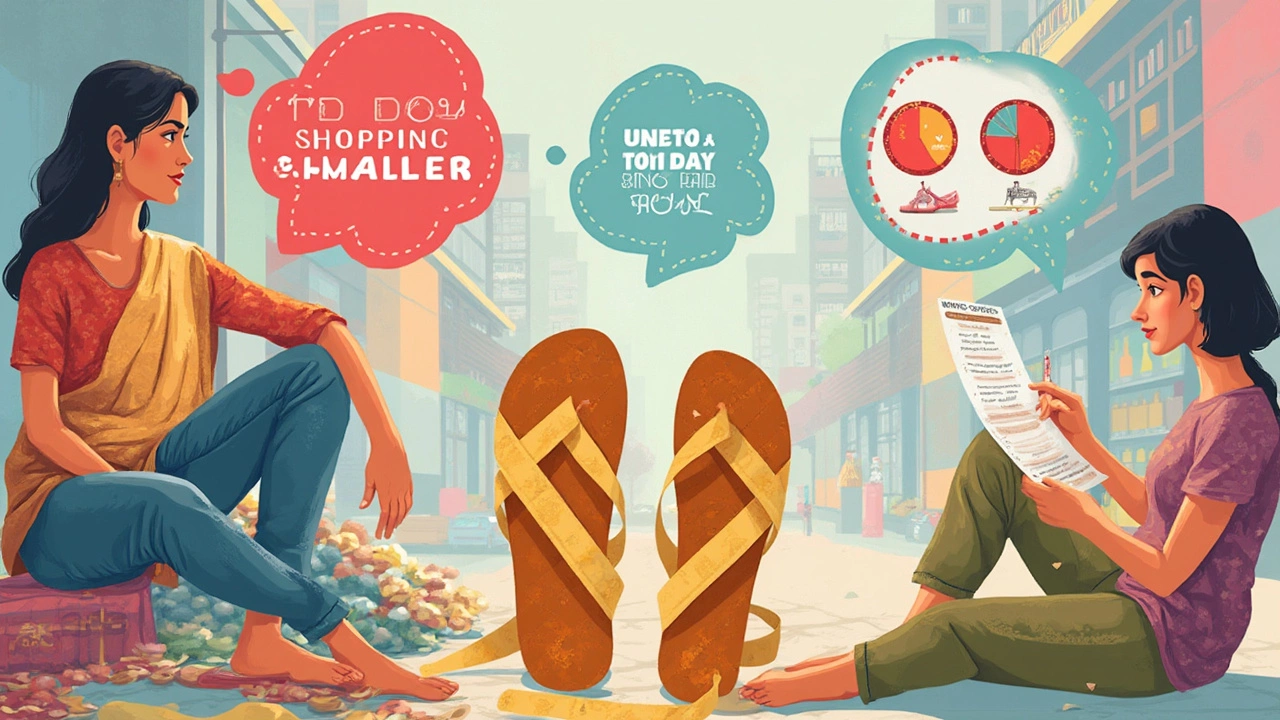Should You Size Up or Down When Buying Slippers? The Ultimate Guide to Comfortable Feet

Ever slipped your feet into a brand new pair of slippers and felt instant regret? The wrong fit can turn lazy Sundays into annoying shuffles, or worse—cold toes and heel blisters. Slippers are the quiet heroes of home comfort, but picking the perfect pair isn’t as simple as it looks. Should you grab the next size up, or is it safer sticking with your usual, even if it feels snug? The answer might actually surprise you.
Why Slipper Sizing Has Everyone Guessing
Pop into any shoe store or scroll through online reviews, and you'll find a mess of conflicting advice. Some brands run small, others are massive. Half-sizes? Nearly non-existent! Slippers don’t play by the same rules as sneakers or flats, adding to the confusion. The reason is that slippers prioritize coziness and easy slipping on/off. But that flexibility means they also tend to stretch out over time—especially styles made from natural fabrics like wool, suede, or leather.
This stretching can cause standard size charts to go out the window. In one 2021 survey reported by the American Podiatric Medical Association, over 60% of people said they ended up with slippers that didn’t fit as expected. That’s no surprise when you consider that manufacturers rarely stick to universal sizing. Sometimes, that European 39 looks more like a small US 7½—or a spacious 8½—depending on how it’s made or which brand makes it.
To add another layer, slippers are usually designed with either a closed-back (like your classic moccasin) or an open-heel ('slide-on' style). This difference matters. Closed-back slippers hug your heel and can feel tight if you go smaller, but open-heel types can flop right off if you size up too much. And let’s not even start on fluffy-lined ones—they compress, but not always as much as you’d think.
If you’ve ever felt like every pair you buy is a mystery bag, you’re not alone. Precise, accurate sizing for slippers just isn’t the gold standard in the industry. Welcome to the slipper wild west!
Bigger vs. Smaller: What the Science (and Real Users) Say
There’s one golden rule most foot specialists can agree on: never force your feet into slippers that are too tight. This can cause not only discomfort but actual problems—think friction blisters, bunions, and even blocked circulation over time. A study at the University of Pittsburgh’s Department of Physical Therapy found that slippers worn a size too small increased the risk of developing plantar fasciitis by about 28%.
But does that mean you should always grab a size up? It’s not that black and white. When slippers are too big, your foot slides and slips, creating its own set of problems: stubbed toes, tripping, even causing joint pain if you walk awkwardly to keep them on. And oversized slippers also tend to wear out faster since the materials bend and buckle in all the wrong places. According to a UK consumer study from 2022, about 35% of people who bought slippers a size too large reported comfort problems or faster breakdown of the soles within six months.
So, what’s the sweet spot? If you ever have to decide, size up—but only by half a size, and only if you’re between sizes or if the slipper is made from a material that shrinks (which is rare). The key is to avoid too-loose and too-snug fits. Real people who shared their feedback on Reddit and Amazon most often said that slippers with adjustable features—like a strap, toggle, or flexible inner—you know, the ones you can tweak a bit—gave them the best long-term fit.
Here’s a quick table breaking down the risks of sizing up vs. down, with data pulled from real studies and consumer reports:
| Fit Choice | Common Problems | Reported User Dissatisfaction (%) |
|---|---|---|
| Size Up | Slipping off, lack of support, faster wear | 35% |
| Size Down | Tightness, blisters, sore feet, circulation issues | 51% |
| True Size | Stretches, usually fits best after a few wears | 14% |
Clearly, more users complain when they buy slippers that are too small, so if you must pick, a half size larger is usually safer than a smaller one—but don’t go overboard.

Materials & Design: The Secret Sauce to the Perfect Fit
You might think it’s all about the number on the box, but what your slippers are made of matters just as much. Take memory foam, for instance—it molds to your foot but usually compresses over the first few wears. Wool and sheepskin? They get roomier over time, up to a half size. Polyester fleece or synthetics usually hold their shape, so there’s less surprise stretch.
Pay attention to the lining, too. Super-fluffy linings feel snug at first but pack down fast. If the slippers are wool-lined or shearling, expect them to feel tight for the first week or so and then gradually loosen. Pro tip: if you’re buying these for the first time and you’re between sizes, it’s often smart to size up, so you’re not squeezed while breaking them in.
Let’s talk construction. Moccasins and house shoes with a closed-heel keep your foot stable, so you should go closer to your usual size. But for slide-on or open-back slippers, a half size up is often less risky, since a tiny bit of extra room won’t send them flying off your feet. If you struggle with swelling (maybe from standing all day, pregnancy, or certain health conditions), erring on the side of a larger slipper is probably best—just make sure the heel isn’t so big it claps like flip-flops.
The bottom line? Your go-to everyday slipper should not require you to grip with your toes to keep them on, and you shouldn’t feel like you’re cramming your foot into a wool sock, either.
Here’s a cheat sheet matching material and slipper type to sizing tips:
- Memory foam or synthetic: Stick to your usual size.
- Wool, shearling, or leather: Size up if you’re between sizes (expect stretching).
- Cloth or cotton, thin lining: Go with your usual size, unless you have wide feet.
- Open-heel slides: Half size up if your regular size barely fits.
- Closed-back moccasins: Usual size, but allow for break-in period.
- Adjustable straps or toggles: Go with your most common shoe size.
Shopping Tips: How to Nail the Right Slipper Fit at Home or in Store
First rule—measure your feet! Your feet might change size during the day, especially if you’re active. Measure both feet at the end of the day, when they’re at their largest. Trace your foot onto a piece of paper, measure from longest toe to heel, and check the width at the widest part. Cross-check with any size chart the brand offers. Don’t rely on your 'standard shoe size' since slippers don’t always use the same lasts (that’s shoemaker talk for the foot-shaped molds they use).
If you’re shopping online, scroll through the reviews and filter by your usual size. Look for comments about sizing up or down and pay special attention to people who mention foot width—wide or narrow feet can totally change how a slipper fits. If you’re in between sizes, see if the slippers come in wide widths or have adjustable features.
Another trick? Wear the same socks you plan to use with the slippers when you try them on—yes, even at home. This changes everything! Winter slippers can feel perfect barefoot but turn into sausages with thick socks.
Whenever possible, buy from retailers who let you return or exchange slippers easily. Don’t be shy about walking around your home on clean floors (nobody wants to return a scuffed pair) to see if the fit stays comfy after a few minutes. Be wary of washable slippers if you plan to buy a tight size—sometimes they shrink a little after the first wash. If you have foot problems like bunions or high arches, look for slippers labeled orthopedic or with extra depth in the toe box.
- Always check the sole, too—memory foam cushions, grippy rubber outsoles, and thicker padding are your friend if you plan to spend hours in them.
- Sizing up? Test to see if your heel comes up when walking fast—if it does, it’s too loose.
- Wondering about durability? Leather and suede outlast synthetic by 2-3 years on average (according to a 2023 Footwear News report).
- Shorter break-in time? Pick slippers with a flexible upper like microfleece or stretch knit.
Buying slippers might seem simple, but these steps can make a world of difference for happy feet.

FAQs and Common Mistakes: Your Slipper Sizing Questions Answered
Still stumped? You’re not alone. Here are the answers to the slipper questions people ask the most, plus some easy-to-make mistakes:
- Can slippers stretch? Absolutely. Wool, shearling, and real leather can stretch up to half a size. Synthetic materials rarely stretch much.
- Should I wear socks with slippers? It depends! If you love thick socks, factor that into your sizing and go up a half size if needed.
- What about half sizes? If available, take them—they’re gold. Otherwise, err on the side of bigger, except for super-structured slippers.
- What’s the worst slipper sizing mistake? Squeezing into a pair because you think 'they’ll loosen up.' If your toes already touch the front, it’s a no-go.
- What if my feet swell? Shop for slippers at the end of the day and look for adjustable features.
- I have wide/narrow feet, what should I do? Seek out brands with specialty widths or slippers with a flexible design. Women’s brands like Vionic and Men’s brands like RockDove offer more options.
- Is it okay if they slip a little at the heel? For open-heel styles, yes, as long as you’re not tripping. For closed-back, no—the slipper should stay put when you walk.
- Will they shrink in the wash? Some do. Check the care instructions, especially for wool or cotton blends.
Most people make their slipper sizing mistakes because they rush, don’t account for how materials act, or trust an old size that’s no longer right. Your feet change with age, weight, and health, so rechecking your fit every year or so is smart.
At the end of the day, slippers should make you forget you're wearing them—not remind you with every step. If in doubt, size up by a half—your feet will thank you for the extra room to relax. Just watch out for flip-flop syndrome and you're golden.
- Jun, 26 2025
- Violet Greenfield
- 0
- Permalink
- Tags:
- slippers sizing
- buy slippers size bigger
- comfortable slippers fit
- slipper shopping tips
- foot health slippers
Written by Violet Greenfield
View all posts by: Violet Greenfield